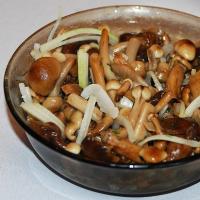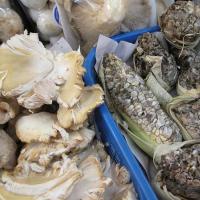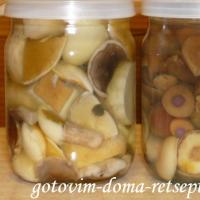Poisonous toadstool mushrooms: photo and description
White grebe, or smelly fly agaric (Amanita virosa) is a deadly poisonous mushroom.
Hat up to 6-12 cm, convex, then flat-convex, sometimes sticky, white, in the central part of the color of butter, often with white remains of the bedspread on the edges. The plates are wide, frequent, free, white.
As you can see in the photo, the leg of this toadstool is white, 1-2 cm thick, 10-15 cm long, covered with flaky white scales with a Volvo at the bottom:


The ring on the leg is white flaky. The pulp is white with an unpleasant taste and smell of chlorine. Spore powder is white.
The white toadstool (fly agaric smelly) grows in mixed and coniferous forests, among mosses on peat soils.
Occurs in August and September.
Light floats (they are without a ring) and champignons (they are without a Volvo, with pinking plates) look like a white toadstool.
The white toadstool is no less poisonous than the pale toadstool, but there are fewer cases of poisoning by the white toadstool, as it has an unattractive "toadstool" appearance and an unpleasant smell.

Pale grebe, or green fly agaric (Amanita phalloides) is a deadly poisonous mushroom.
The pale grebe acquired sinister glory in ancient times. It is known that Emperor Claudius was poisoned by food prepared from a poisonous mushroom, the bride of Tsar Ivan the Terrible, Martha, was poisoned. According to the strength of the poison, the pale grebe has no analogue. 1/2 cap can cause the death of several people. Persistent toxins phalloidin, falloin, amanitin, etc. were found in the pale grebe. Poisons slowly but inevitably affect the internal organs.
Pale grebe is a poisonous agaric fungus with a strong toxic effect. It grows from the end of August until the first autumn frosts, preferring deciduous and broad-leaved forests. Grows under oaks, maples and pines. It is rare, but in some years gives a large harvest. Pale grebe is a rather moisture-loving mushroom and it grows at a time when it is time for the development of many edible mushrooms in the forest: russula, porcini, oak, boletus and many others. During this period, grebes are found not only in deciduous forests. They also come across in pine plantations.
Cap up to 10-12 cm, convex, then flat-convex, smooth yellow-green, olive-green, darker towards the center, radially fibrous, sometimes with whitish remains of the veil. There is a form with a white hat. The bell-shaped cap of young mushrooms becomes prostrate with age, in some varieties it is depressed. Its shiny, silky to the touch surface at high humidity is covered with a thin layer of mucous plaque, sometimes with powdery flakes. The edges of the cap are smooth, even, with hanging remnants of a white veil. The plates are wide, frequent, free, white.
As for the description of the leg of the pale grebe, it is rounded, slightly expanded at the bottom, where it forms a small tuber immersed in a free sac-like volva. The color of the stem is white or pale olive, with a fine moiré pattern. It grows up to 8-10 cm in height, and its diameter is approximately 1-2 cm. In the upper part of the plant leg, the pale grebe has a wide white ring, by which the pale grebe can be easily distinguished from edible counterparts and thus avoid a fatal mistake. The flesh is white, sweetish, with a slight sugary sweet smell. Spore powder is white.
Occurs in August - September.
These photos show the white and pale grebes described above:


The pale grebe is deadly poisonous. The poison contained in the tissues of the pale grebe is very stable and does not decompose during any kind of processing, including prolonged boiling. Its lethal dose for an adult is contained in 30 g of mushroom pulp, for a child - in 5-10 g.
All proven cases of fatal poisoning of people with mushrooms are associated with the use of pale grebe, when it was mistaken for russula of a suitable color or for champignon.
The greatest number of poisonings occurs in July - October, the growing season of pale grebe.
How to distinguish a pale grebe from edible mushrooms
With a careful assessment of each plucked mushroom, the pale grebe can be distinguished from other edible mushrooms. Unlike the colors of the rainbow, you don't want to look at them. And the shape of the mushroom is quite attractive, slender. The ratio of the height of the stem and the diameter of the cap are in a harmonious combination.
When describing the toadstool fungus, the following characteristic features are distinguished: at the base of a thin cylindrical leg there is a tuberous thickening (mace), and the collar-mushroom, as it were, grows out of the cover, and in the middle of the leg there is a ring of film. The greens, with which the pale grebe is also confused, do not have them.
The plates of pale grebes are white (both in young and old specimens), spores are colorless. In champignons, with which toadstool is most often confused, the underside of the cap is pinkish-brown, darkening to black as the fungus ripens.
But the most important difference between a pale grebe and a toadstool is the smell. Toadstool does not smell, and champignon has anise or almond smell.
If you do not know how to distinguish a toadstool, it is better to bypass the suspicious mushroom.
Signs of pale toadstool poisoning
The first signs of toadstool poisoning do not appear immediately, after 10-12 hours, and sometimes 30 hours after eating the fungus and are accompanied by headache, dizziness, impaired normal vision and restlessness. The patient feels intense thirst, burning pain in the stomach, cramps in the limbs. This is followed by cholera-like attacks in the form of bilious vomiting and severe diarrhea. Urine is dark and is excreted in small quantities. Severe pains are felt in the liver, especially when pressed. There is profuse sweat, the limbs become cold, and death occurs in a day or two. In 90% of cases, poisoning with a pale grebe or grebe-shaped fly agaric is fatal.
If there is even the slightest suspicion of poisoning with a pale toadstool, then it is better to play it safe than wait, and urgently seek qualified medical help, since treatment is effective only during the first twenty-four hours. It is also necessary to hospitalize all members of the victim's family who have eaten mushrooms at least in a minimal amount, even if there are no symptoms of mushroom poisoning at the time of the ambulance's arrival. These symptoms may appear when it is already too late.
Periodically, in some southern regions of Russia (for example, in Voronezh), whole epidemics of mushroom poisoning are observed, apparently, pale grebes. The population there has a very poor understanding of their characteristics and literally sweeps away all the mushrooms in a row when they appear in the forest. In the northern, traditionally "mushroom" regions, cases of poisoning are extremely rare.



